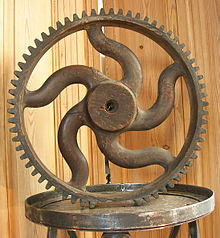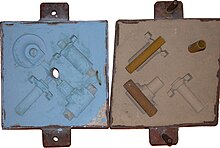

In casting, a pattern is a replica of the object to be cast, used to form the sand mould cavity into which molten metal is poured during the casting process. Once the pattern has been used to form the sand mould cavity, the pattern is then removed, molten metal is then poured into the sand mould cavity to produce the casting. The pattern is non consumable and can be reused to produce further sand moulds almost indefinitely.
Due to the fact that almost all metals contract or shrink as their temperature falls, casting patterns must be made larger in size than the actual casting they will produce. Aluminium casting contraction is ~1.3% for example, so patternwork for a cast aluminium part would be made 1.3% bigger than the cast part itself.[1][2]
Patterns used in sand casting may be made of wood, metal, plastics or other materials. Patterns are made to exacting standards of construction, so that they can last for a reasonable length of time, according to the quality grade of the pattern being built, and so that they will repeatably provide a dimensionally acceptable casting.[3]
- ^ Bawa, H S (2004). Manufacturing Processes – I. Tata McGraw-Hill. pp. 1–12. ISBN 978-0-07-058372-6.
- ^ Ammen, C. W. (1999). Metalcasting. McGraw-Hill Professional. pp. 159–176. ISBN 978-0-07-134246-9.
- ^ "Types of patterns used in Casting Process - Mechanical Engineering".